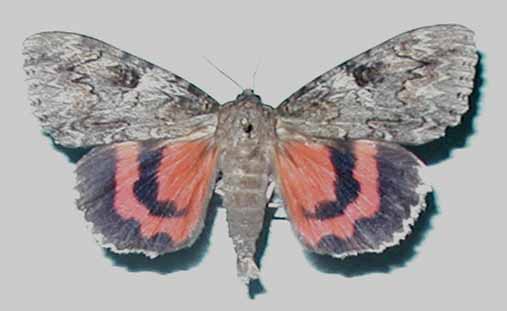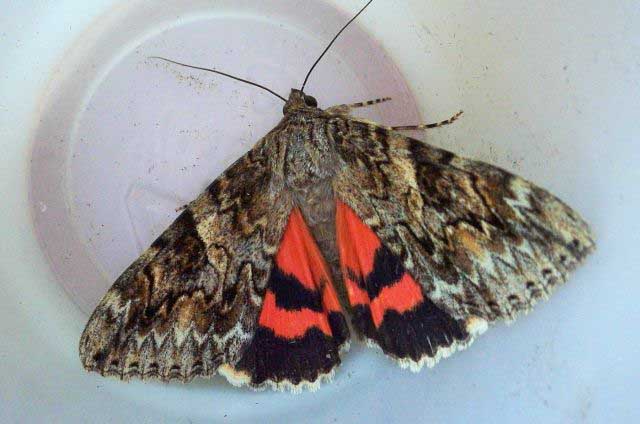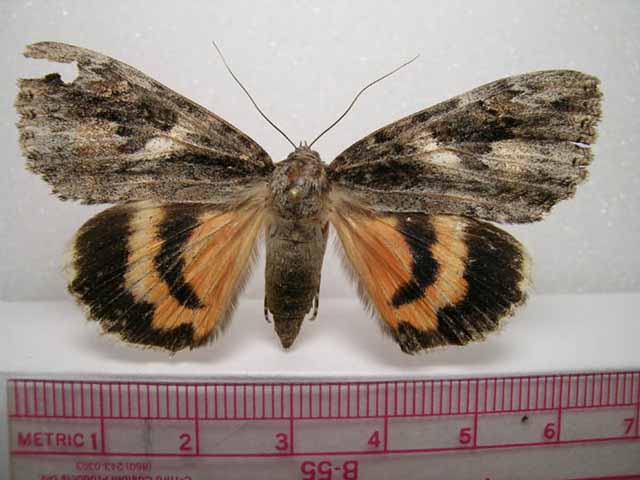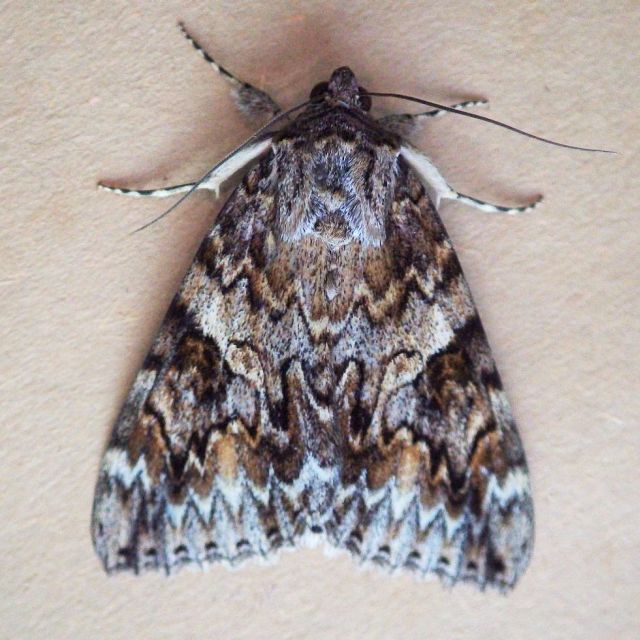Catocala irene
Catocala irene
kah-TOCK-uh-lahMEYE-reen
Behr, 1870

Catocala irene courtesy of David Wikle

Catocala irene, Wolf Creek, Josephine County, Oregon,
August 18, 2015, courtesy of Edna Woodward.
This site has been created by
Bill Oehlke at oehlkew@islandtelecom.com
Comments, suggestions and/or additional information are welcomed by Bill.
| TAXONOMY:
Superfamily: Noctuoidea
Family: Noctuidae
Group: Noctuinina
Subfamily: Catocalinae
Genus: Catocala, Schrank, 1802
| |
MIDI MUSIC
"Moon River"
copyright C. Odenkirk
MIDI CITYON.OFF
<bgsound src="moon.mid" LOOP=FOREVER>
|
DISTRIBUTION:
Irene's underwing, Catocala irene
(wingspan: 65-75mm), flies in Utah
and California and
Nevada.
Dr. Wayne Whaley reports "C. irene is very
common in Utah. In Utah County, Utah it can be one
of our most common species in some localities, especially
along the eastern flanks of Utah Lake in August. It feeds on
fragile willow (Salix fragilis) and probably others. I have
reared many on quaking aspen."
It has also been reported in Idaho,
Oregon,
Washington and
Wyoming.
David Wikle reports C. irene August 11, 2003, from
Bonita, San Diego County, California.

C. irene, August 6, 2001, Pinnacles National Monument,
San Benito, California, courtesy of Paul Johnson.
The darkest regions on the grey brown forewing include the upper half of the basal area and the area surrounding
the reniform spot with a very indistinct arc toward the apex. The
subreniform spot is considerably lighter and seems to open into the
region between the postmedial and subterminal lines.
The inner black band of the hindwings comes to a point well before
reaching the inner margin. The outer band shows considerable
scalloping near the anal angle. |  |
Henry Edwards described two forms
and a subspecies in
1880:
"volumnia" Hy. Edw., 1880, form
"virgilia" Hy. Edw., 1880, form
subspecies valeria Hy. Edw., 1880
I also note that the pm line emanates from the costa directly above the reniform spot and travels as a thin black line along the lower costal edge a
considerable distance before beginning a decidedly straight, oblique (rather than an irregular curve) run to the tip of the first upper tooth. This character
helped me the most in determining the specimen from Wolf Creek, Josephine County, Oregon.

Catocala irene, Wolf Creek, Josephine County, Oregon,
August 18, 2015, courtesy of Edna Woodward.
FLIGHT TIMES AND PREFERRED FOOD PLANTS:
Catocala
irene flies as a single
generation with moths on the wing from late July to early September.
The Catocala irene caterpillar feeds on poplar and willow.
ECLOSION:
Adults eclose from pupae formed under leaf litter.
SCENTING AND MATING:
Catocala irene females
emit an airbourne pheromone and males use their antennae to track the
scent plume.
EGGS, CATERPILLARS, COCOONS AND PUPAE:
Eggs are deposited on tree bark in the fall and hatch the following spring.
Mature larvae Image courtesy of |
 |
Larval Food Plants
Listed below are primary food plant(s) and alternate food plants.
It is hoped that this alphabetical listing followed by the common
name of the foodplant will prove useful. The list is not exhaustive,
although some species seem very host specific.
Experimenting with closely related foodplants is worthwhile.
Populus.....
Salix
|
Poplar
Willow |
This page is brought to you by Bill Oehlke and the
WLSS. Pages are on space rented from Bizland. If you would like to become a "Patron of the Sphingidae/Catocala Sites",
contact Bill.
Please send sightings/images to Bill. I will do my best to respond to requests for identification help.
Enjoy one of nature's wonderments: Live Saturniidae (Giant Silkmoth) cocoons.

|

To show appreciation for this site, click on the flashing
butterfly to the left, a link
to many worldwide insect sites. |
Return to Canadian Index
Return to Main Index






